Ian MacMillan, Burn Stewart Master Blender
Ian MacMillan, Head of Distilleries and Master Blender for Burn Stewart has seen many changes in his forty years in the industry; the saddest trend being the total automation in many distilleries with notable absence of people.
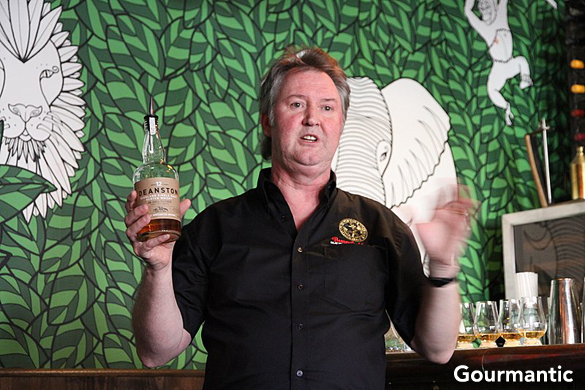
Ian MacMillan, Head of Distilleries and Master Blender
“Whisky should be made traditionally and drunk traditionally”, he explains at a masterclass held at The Wild Rover in Sydney. When you remove the human element, you remove the style of the whisky.
Ian MacMillan led a tasting of four different styles of whisky from three of Burn Stewart’s distilleries.
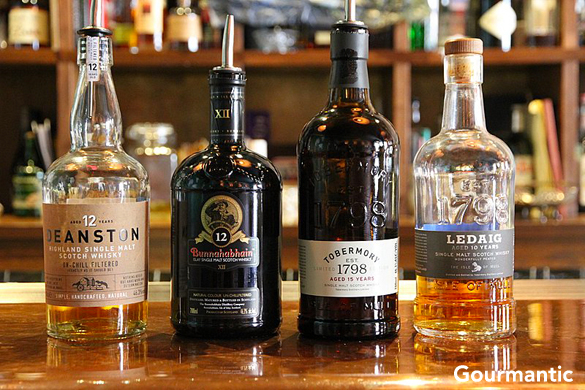
Deanston, Bunnahaibhan, Tobermory, Ledaig
Deanston 12 yo
Deanston is a relatively young distillery in Perthshire that has only been around since 1966. The distillery produces a whisky, non-chill filtered with the strongest honey characteristic of all Scotch whiskies. On the nose, Deanston 12 yo is rich with honey and faint eucalyptus. On the palate, it is prevalent with barley sugar sweetness, heather honey, followed by citrus notes and a long but soft finish.
Bunnahabhain
The Bunnahabhain distillery is located on the most remote part of Islay in the north east. The name means “mouth of the river” in Gaelic, and the whisky is not the type the Scottish island is renowned for.
From 1881 to 1963, Bunnahabhain made heavy, oily and smoky whiskies but since 1963, they have stopped malting barley on site.
Bunnahabhain is made from unpeated barley. On the nose, it has currants and raisins which come from the maturation in first fill Oloroso sherry casks, which also give it sweetness. On the palate, there is chocolate, coffee and Christmas cake with roasted nuts and a sweet saltiness on the finish, a characteristic of costal distilleries.
Tobermory 15 yo
Tobermory Distillery is located on the Island of Mull, a mountainous island that holds a single distillery. Although it was founded in 1798, records show that it had been distilling 300 years earlier.
The distillery employs S-shaped stills which create a heavy reflux but with no iodine character. Tobermory 15 yo is made from unpeated malted barley. A layered whisky, on the nose, it has coffee aromas, chocolate, toffee, deep sherry and opens up to more coffee-like character. Complex on the palate, it starts with strong sherry components and evolves to coffee, chocolate and fruit notes.
Ledaig 10 yo
For Ledaig, pronounced Led-chig, Ian MacMillan wanted to recreate an old style of whisky, sweet and smoky but without the medicinal character of peated whiskies from Islay.
Ledaig 10 yo is produced in the Tobermory distillery on the Island of Mull which employs the S-shaped stills. The whisky has considerable peat on the palate but more earthy without the iodine component. A sweet, smoky and lingering finish gives the dram a distinctive character unlike any other.
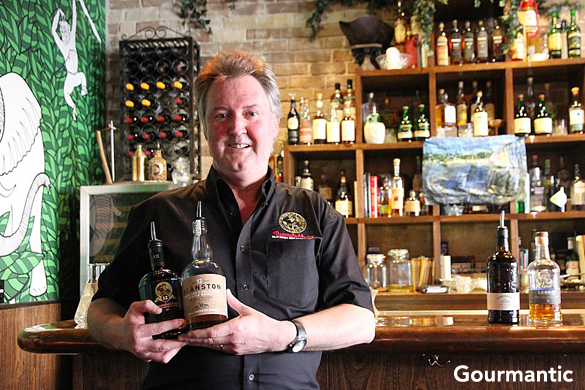
Ian MacMillan at The Wild Rover
The whisky masterclass with Ian MacMillan was held on Monday 17 February 2014 at The Wild Rover in Surry Hills.

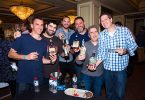
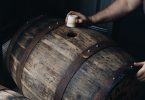

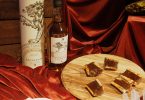
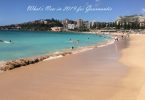
[…] our bipolar Sydney summer weather, on coolish nights, we’re enjoying Ledaig 10 yo, a heavily peated single malt whisky from the Isle of Mull, neat after dinner on those coolish […]
[…] reviewed including Laphroaig with the Opinions Wanted campaign, The Balvenie, Glenfiddich, Hakushu, Ledaig, Hudson Whiskey and […]
[…] David Prior purchased it and set to revive the distillery with master distiller and blender Ian MacMillan, former Burn Stewart Master […]
[…] paired with green tea sorbet, South Island 21 YO from New Zealand paired with ANZAC biscuits and Tobermory 15 YO paired with orange dark […]